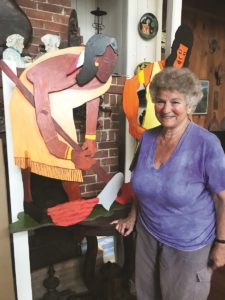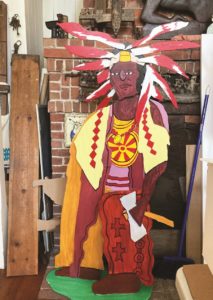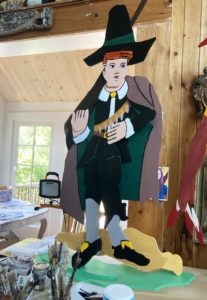“It’s historical; it’s interactive; you walk through it,” Mimi Gross says. She is describing how museum-goers will experience The Arrival, 1620, her site-specific installation that is opening on Friday, Oct. 2, at the Provincetown Art Association and Museum. Theatrical staging leads viewers through scenes representing the first contact between the indigenous people who farmed the Outer Cape for eons and the Pilgrims who were escaping religious persecution — and carrying muskets.

“You’ll walk through the gallery, passing the figures, and then, there’s the Mayflower, crashing from the wall,” Gross says. “The Wampanoag people were planting, cooking, and fishing, standing around, when, suddenly — this shock.”
Gross, the daughter of sculptor Chaim Gross and Renee Gross, was a young girl when her family bought their hilltop home in Provincetown’s West End, which was built by painter George Elmer Browne, founder of the West End School of Art. Its spacious, windowed studio is now Mimi’s seasonal retreat. She spoke as the numerous life-size figures that she first sketched, made into maquettes, then shaped in plywood, and painted in her exuberant style were readied for their installation at PAAM, where Gross first exhibited a painting at age 16.
A precocious artist while still a student at Bard College, Gross was invited to show in Provincetown’s legendary Sun Gallery, a mecca for painters working in a loosely gestural, figurative style. Considered risqué in its time, the Sun was censored by local officials for the nudes it included in an exhibit.
“I loved the people who showed there,” Gross says. “I was just a teenager, and happy to be participating. It was the first gallery where I showed, in Provincetown or anywhere.” Red Grooms also showed at the Sun. They married, traveled together, and have a daughter, Saskia Grooms. Collaborators from 1960 to 1976, Gross and Grooms famously created Ruckus Manhattan, a circus-like installation dramatizing the hubbub of the times.

At age 80, Gross has a résumé that lists filmmaker, sculptor, painter, and educator, as well as set and costume designer for the Douglas Dunn dance troupe, for which Gross continues to explore movement and rhythm. She also creates low-relief group portraits that read as dimensional paintings. The Arrival, she says, is her most technically advanced, multi-dimensional piece.
Gross is also a habitué of Herring Cove Beach. For as long as she can recall, she sketched there, with her father and with friends. “I recently did a lot of dimensional pieces, made of wood, based on those beach sketches,” she says. They were shown at the Brooklyn Museum as part of the exhibit “Coney Island: Visions of an American Dreamland.” Gross arranged her almost two dozen multi-racial figures in congenial groups that filled 36 square feet.
“Pieces for The Arrival are more sculptural,” Gross says. Some figures are five feet high and four feet wide. Attached to a base, they appear even taller and are painted on both sides. “These are a lot more varied than the work I did for the Coney Island show,” she says.
The journey leading to The Arrival began three years ago, when Breon Dunigan, sculptor and member of PAAM’s exhibition committee, met Gross at Herring Cove. “It was late September, and Mimi was swimming,” Dunigan says. “I knew who she was. We have friends in common, but I didn’t really know her work.” Gross invited Dunigan to visit her studio that very afternoon.
Dunigan was immediately smitten. She proposed a show of Gross’s work to PAAM, its exact nature undetermined. As 2020 loomed, Christine McCarthy, PAAM’s CEO, was looking for an exhibition marking the arrival of the Mayflower.

“It was totally up to Mimi,” Dunigan says of the Mayflower idea. “I didn’t want her to do anything she wasn’t comfortable with. But I did think it would be amazing, and I was right.” Dunigan laughs. When it was time to collect the artwork from Gross’s Manhattan studio, she drove a large van to the city with her son, Liam Bailey, during a rainstorm. They assisted with wrapping the delicate cargo and transported it to the Cape.
The finished pieces went to PAAM, and others, in various stages of completion, went to Gross’s hilltop workspace. Gross’s skill in portrait painting, and the historical research underpinning the installation, is everywhere evident: figures are individualized, assigned a personality. Dark-skinned Wampanoag men are painted in reds and yellows. Garments and accessories are never purely functional: a love of pattern and bright color is reflected in feathered headdresses, shields, and neck ornaments. Women till the land, their hair neatly braided and deerskin dresses fringed. A black-hatted Pilgrim, in knickers and buckled shoes, carries a musket. His smile is tentative, as if asking what comes next.
McCarthy made her own pilgrimage to Gross’s studio. “Mimi’s narrative is crafted through the lens of supporting the Wampanoag people, challenging the history books, and bringing a new awareness to something that happened 400 years ago,” McCarthy says. “Each figure has its own personality, and seeing them in real life, as opposed to digital images, is astounding. The message delivered through the installation will go way beyond the actual artwork.”
The daughter of an immigrant artist who made a home in Provincetown, Gross provides a complex, contemporary interpretation of the Outer Cape’s — and the country’s — foundational history. “These peaceful people had been living here for thousands of years, and along came others looking for their own freedom, who couldn’t have cared less about those here already,” Gross says, giving voice to a narrative, through dimension, color, and gesture, of a people whose descendants continue to be silenced.

Culture Clash
The event: “Mimi Gross: The Arrival, 1620,” a site-specific installation
The time: Friday, Oct. 2, through Nov. 29; Wednesday through Sunday, 11 a.m. to 5 p.m.; time-slot reservations required at paam.org
The place: Provincetown Art Association and Museum, 460 Commercial St.
The cost: $12.50; members free
Reporting for this article was supported by a grant from the Provincetown Cultural Council, a local agency supported by the Mass. Cultural Council.



